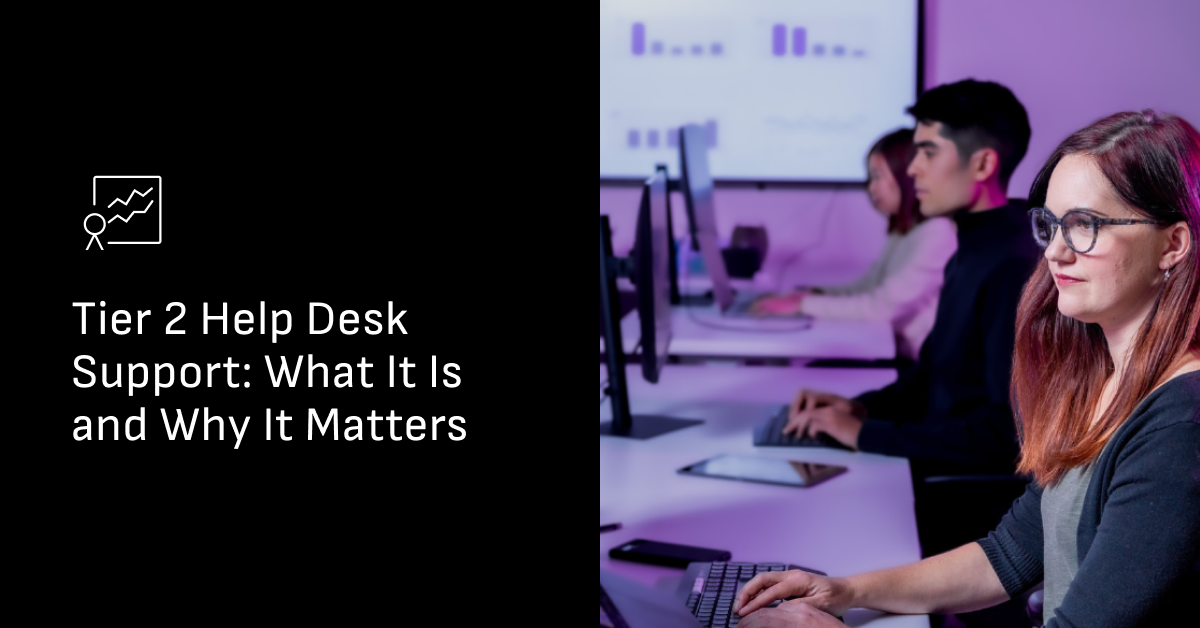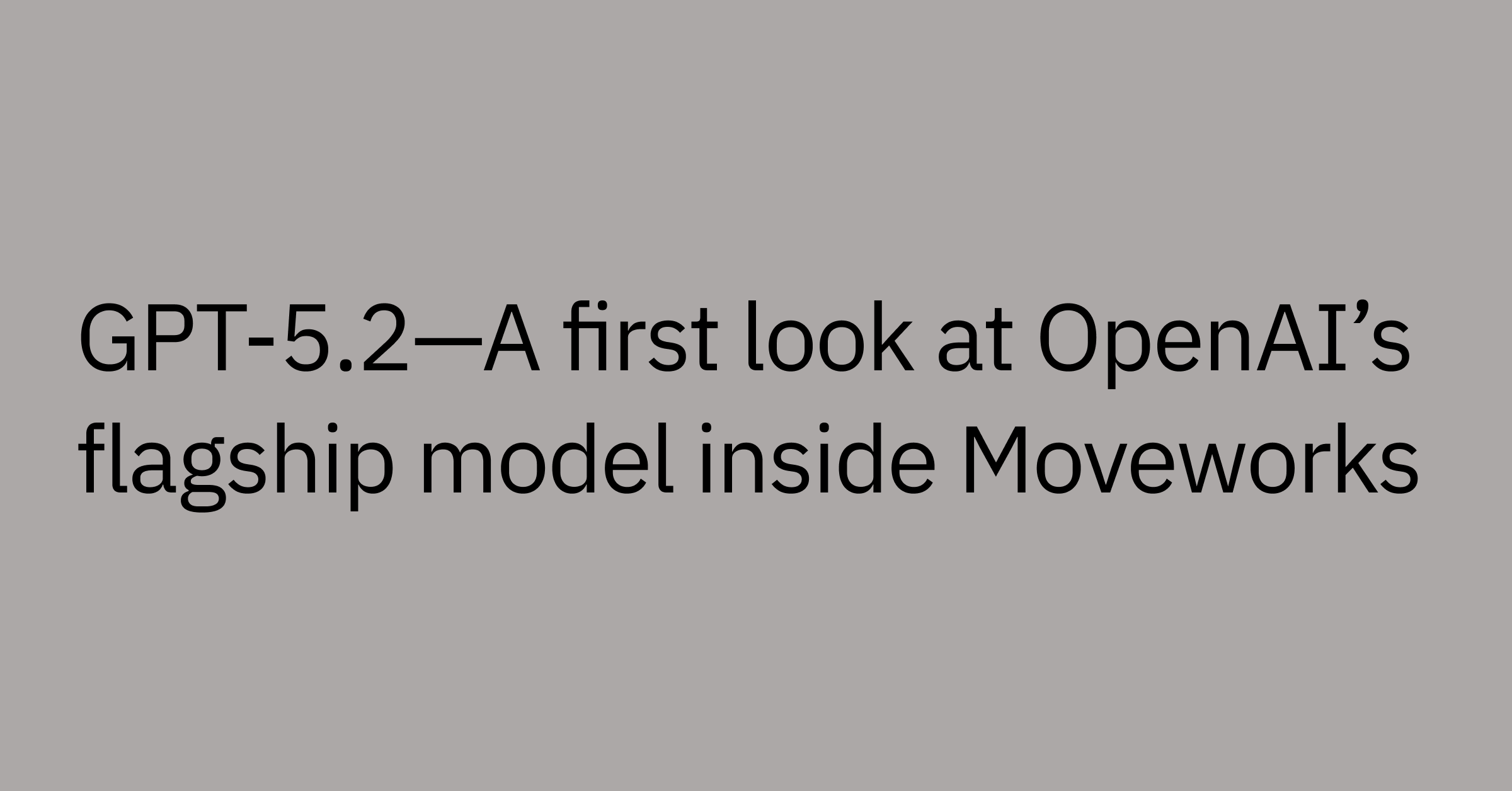Table of contents
Highlights
- Tier 2 IT support resolves complex, escalated cases that require deeper technical analysis and system expertise than Tier 1.
- Delays in Tier 2 often stem from poor handoffs, disconnected tools, and unclear escalation workflows.
- AI at lower tiers handles routine cases, while for Tier 2 AI enriches escalations with full context for faster, more precise resolution.
- Proactive AI analytics improve consistency, accuracy, and visibility across the escalation pipeline.
- Moveworks AI Assistant automates Tier 1 requests and provides contextualized tickets that streamline Tier 2 operations.
A senior network administrator at a growing tech company, glances at her queue and sees fifteen tickets waiting... all of which were escalated from tier 1 support with incomplete information.
The first ticket simply says, "Email broken," with no additional context about the user's device, error messages, or any troubleshooting steps that have already been attempted. The second mentions a VPN issue, but lacks any details about which client software or connection protocols are involved.
These kind of scenarios often lead to IT support teams to look into a better approach: more defined roles and responsibilities, tools that support escalation workflows, and trying to optimize tier 2 efficiency without overloading higher-tier staff. Yet while some issues are able to be resolved automatically at tier 0 and tier 1 levels, expert human support staff remain critical for resolving more complex technical challenges.
Employees expect fast and effective resolution regardless of issue complexity. Organizations that successfully streamline their tier 2 operations often see significant improvements in both employee satisfaction and IT team productivity.
The trick lies in understanding how artificial intelligence (AI) and automation can support these specialized teams while preserving the deep expertise that complex tier 2 issues require.
What is tier 2 help desk support?
Tier 2 help desk support provides advanced troubleshooting and resolution for complex technical issues that can’t be resolved by tier 1 support.
This level involves specialists with deep technical expertise who handle issues related to specific system configurations, network problems, and software bugs — often escalating only the most complex cases to tier 3 support when absolutely necessary.
Within the broader support hierarchy, tier 2 serves as the middle layer between frontline support and specialized engineering teams. This role requires a unique combination of technical depth and contextual awareness that distinguishes it from both simpler tier 1 requests and higher-level tier 3 work.
- Tier 1 vs Tier 2: What sets tier 2 apart from tier 1 is the level of technical investigation that's required. While tier 1 focuses on common, well-documented issues with standard resolution paths (like password resets), tier 2 handles problems that require deeper system knowledge and custom troubleshooting.
- Tier 2 vs Tier 3: What differentiates tier 2 from tier 3 is its scope and level of specialization. Tier 2 teams work within established system boundaries and known technologies, while tier 3 often tackles architectural changes, custom development, or vendor escalations.
Common tier 2 support issues
Tier 2 support teams often handle technical issues that require specialized knowledge and system-level access, typically falling into the following categories.
- Software configuration errors: These may include settings that require registry modifications, group policy adjustments, or complex permission configurations that go beyond standard user access.
- Hardware malfunctions requiring diagnostic expertise: These issues often involve running diagnostic tools, interpreting system logs, and coordinating with multiple teams to identify root causes — rather than performing simple part replacements.
- Network connectivity problems: VPN setup, single sign-on (SSO) authentication, and network routing issues require deeper technical insight and often involve multiple systems working together.
Permission and access management requests: These requests might involve provisioning secure access, configuring role-based permissions, or troubleshooting authentication failures across integrated platforms.
Who handles tier 2 help desk support?
Tier 2 support teams typically include technical support specialists, IT operations analysts, and system or application support engineers. Each role brings specific expertise while maintaining the flexibility to collaborate across different technical domains.
Tier 2 team members need skills such as:
- System-level troubleshooting
- Familiarity with scripting languages and diagnostic tools
- Deep knowledge of enterprise platforms like ITSM and endpoint management systems
Educational backgrounds often include technical certifications, relevant degrees, or equivalent hands-on experience with enterprise technologies.
Successful tier 2 teams frequently collaborate with both tier 1 and tier 3. They work closely with tier 1 to understand escalation context and provide guidance on when issues should move up the chain.
With tier 3, they coordinate on highly complex problems that require even more specialized expertise while making sure proper documentation and knowledge transfer takes place between tiers.
Unlike the repetitive nature of tier 1 issues, tier 2 problems usually require a human touch to figure out the nuances and apply customized solutions, which makes them harder to automate.
This variability means each ticket takes more time and expertise, naturally, slowing down workflows and requiring frequent adjustments to how problems are resolved.
Common challenges for tier 2 help desk teams
Tier 2 support teams deal with a mix of challenges that can affect how efficiently and effectively they work. Recognizing these pain points helps identify where smart changes can make the biggest difference.
Incomplete or poorly routed tickets
Tickets often reach tier 2 without the context information support staff need for efficient resolution. When escalations are missing relevant logs, device specifications, or details about previous troubleshooting attempts, tier 2 teams spend valuable time redoing work already attempted by tier 1.
This information gap leads to slower resolution times and frustrated employees who have to repeat themselves.
Detailed escalation notes — covering error messages, system configurations, and past actions — enable tier 2 teams to focus immediately on advanced troubleshooting rather than basic information gathering.
Poor routing makes things even harder when tickets that could’ve been handled by tier 0 or tier 1 get escalated unnecessarily — or when issues needing tier 3 expertise get stuck in tier 2 queues.
Skill development challenges
Keeping tier 2 staff up to speed with the latest technologies means investing in ongoing training and development to ensure they have the skills they need.
With tools and systems changing rapidly, skills relevant today may become outdated quickly. Teams need ongoing education in new tools and systems, as well as evolving best practices and emerging security requirements.
Disconnected tools and systems
Finding answers often requires support agents to navigate multiple systems including email platforms, ITSM systems, remote access tools, and HRIS databases.
These disjointed workflows slow things down, making it take longer to resolve issues. Technicians end up wasting time jumping between systems, hunting for information, and manually updating several platforms with resolution details.
When systems don't integrate well, important context is often lost between handoffs, leading to duplicated effort or inconsistent documentation.
User expectations and coordination pressures
Managing employee expectations for resolution times is hard when complex tier 2 issues require thorough investigation and testing. Unlike straightforward tier 1 problems with predictable resolution timeframes, tier 2 issues often involve unknown variables that make accurate time estimates difficult.
Coordination with other tiers creates additional pressure. Tier 2 teams often feel the pressure to close tickets quickly, but without clear visibility into business impact or urgency, it can lead to less-than-ideal prioritization decisions.
AI tools can help address this challenge by surfacing patterns from historical ticket data, suggesting priority based on business impact, and providing guidance on resolution paths that have been successful for similar past issues.
How to streamline tier 2 support
Improving tier 2 operations takes a smart approach — boosting workflow efficiency while keeping the human expertise needed for handling complex problems.
Automate ticket resolution at lower support tiers
AI automation for tier 0 and tier 1 support can significantly reduce the volume of tickets that escalate to tier 2 teams. When systems automatically resolve common issues like password resets or basic troubleshooting, fewer routine matters escalate unnecessarily.
This automation provides tier 2 teams with more time to focus on issues that genuinely require their specialized knowledge.
Upskilling frontline support staff through training programs also helps make sure that issues reaching tier 2 truly require advanced intervention, improving efficiency across the support organization.
When tier 1 teams have better tools and knowledge, they are able to resolve more problems independently.
Tier 2 support tools to drive efficiency
Several categories of tools help support teams resolve tier 2 issues more efficiently, each offering specific value for different aspects of the support process:
- AI-powered ticket automation tools are able to enrich incoming tickets with relevant context from integrated systems, helping support staff understand issues more quickly. These tools may also suggest resolution paths based on historical data.
- Remote access and control tools allow technicians to diagnose and resolve problems directly on user devices, eliminating the back-and-forth communication that often extends resolution times.
- Asset management tools provide visibility into hardware and software configurations, helping support teams understand the complete technical context surrounding each issue.
- Workflow automation tools link collaboration platforms with ITSM systems, making sure information moves smoothly between team members and keeps everyone updated on progress and resolution status.
- Enterprise search tools help technicians quickly locate relevant documentation, past solutions, and expert knowledge across the organization's knowledge bases.
Not all tools offer the same level of support, though.
AI-powered solutions go beyond basic automation by interpreting context, learning from patterns, and suggesting next steps based on comprehensive analysis rather than simple rule matching.
Advanced tools may automatically update knowledge bases with successful resolutions, helping teams build institutional knowledge that improves future response times. More sophisticated platforms are designed to perform routine system checks automatically, allowing human support agents to focus on complex analysis and problem-solving tasks.
Best practices to provide better tier 2 support
Using proven practices helps organizations improve their tier 2 operations while keeping IT service quality and team performance on track.
Best practices to provide better tier 2 support
Using proven practices helps organizations improve their tier 2 operations while keeping IT service quality and team performance on track.
Standardize escalation workflows
Establishing clear escalation workflows and documentation standards between tier 1 and tier 3 ensures the consistency tier 2 teams need for efficient service desk operations.
Collaboration tools and shared communication channels help ensure that all relevant context travels with escalated tickets. When teams use standardized templates and documentation formats, tier 2 technicians spend less time deciphering handoff and more time resolving issues.
Automation can also help capture ticket metadata consistently. When systems automatically gather relevant technical details, user information, and escalation context, human technicians receive complete information packages rather than incomplete, generalized summaries.
Measure and monitor tier 2 support metrics
Regular monitoring of support metrics helps identify improvement opportunities and makes sure that service levels meet organizational expectations.
Some key metrics to track include mean time to resolution (MTTR), first-call resolution rates, customer satisfaction (CSAT) scores, and ticket volume trends.
Escalation patterns between tiers can also give helpful insights into training needs, how effective tools are, and ways to improve workflows — offering insights for continuous improvement.
Shift to proactive support
Implementing AI tools to analyze and group recurring issues helps support teams transition from reactive troubleshooting to proactive problem-solving.
When systems identify patterns in incident data, teams are able to address root causes before they generate large volumes of individual tickets. This approach often prevents problems rather than simply responding to them after they occur.
Proactive monitoring tools may identify system performance issues, configuration errors, or security concerns before they impact end users, letting teams resolve problems during planned maintenance windows, before they disrupt business operations.
Boost tier 2 performance by automating tier 0 and tier 1 with AI
Tier 2 teams operate more efficiently when tier 0 and tier 1 support are resolved before they ever escalate.
By introducing AI-powered automation at the front lines of support, organizations can streamline operations, reduce workload, and ensure that only complex problems reach tier 2.
Moveworks makes this possible through a single agentic AI Assistant that transforms the support experience. It empowers employee self-service support and creates a more intelligent and scalable support strategy.
Moveworks helps optimize tier 2 operations by:
- Enabling employee self-service: Revolutionize the support process with an AI Assistant that is able to resolve issues, surface answers, file tickets, and streamline communications — with little to no human intervention.
- Helping to eliminate L1 support tickets: Free your help desk from Tier 1 queues with autonomous resolution of the most routine and repetitive requests.
- Boosting workforce efficiency: Deliver faster solutions, accurate information, and seamless support experiences to employees across your entire organization.
By automating lower-tier support and integrating seamlessly across systems, Moveworks helps enable tier 2 agents receive enriched, contextualized tickets — so they can skip the busywork and focus on solving the toughest problems and doing impactful work.
Find out how AI automation can elevate your support operations. Request a demo to see how Moveworks sets the stage for tier 2 success.



